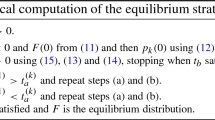Abstract
A queueing system with nonidentical service channels, a regenerative input, and a renewal service process at each channel is considered. The ergodic conditions are found when the basic process describing the system (and including the queue-size and the waiting time vector) is regenerative with finite expectation of the regeneration cycle length. The asymptotic properties of the embedded renewal process of the regeneration points are used. The zero-delayed and delayed cases are considered separately. Some queueing network applications are discussed.
Similar content being viewed by others
References
S. Asmussen,Applied Probability and Queues, Wiley, New York (1987).
F. Baccelli and S. Foss, “Ergodicity of Jackson-type queueing networks,”Queueing Systems,17, 5–72 (1994).
K. Balagopal, “On queues in discrete regenerative environments, with application to the second of two queues in series,”Adv. Appl. Probab.,11, 851–869 (1979).
C.-S. Chang, J. A. Thomas, and S.-H. Kiang, “On the stability of open networks: a unified approach by stochastic dominance,”Queueing Systems,15, 239–260 (1994).
S. Foss, “Ergodicity of queueing networks,”Sib. Mat. Zh.,32, 184–203 (1991).
H. Kaspi and A. Mandelbaum, “Regenerative closed queueing networks,”Stoch. Reports,39, 239–258 (1992).
E. Morozov, “Some results for continuous-time processes in a queue GI/GI/I with losses,”Izv. Byeloruss. Acad. Nauk,2, 51–55 (1983).
E. Morozov, “Conservation of regenerative input in the acyclic queueing network,” in:Stability Problems for Stochastic Models [in Russian], VNIISI, Moscow (1988), pp. 115–119.
E. Morozov, “A comparison theorem for queueing system with nonidentical channels,”Lect. Notes Math.,1546, 130–133 (1993).
E. Morozov, “Wide sense regenerative processes with applications to multi-channel queues and networks,”Acta Appl. Math.,34, 189–212 (1994).
E. Morozov, “An extended regenerative structure and queueing network simulation,”Sci. Report, No. 199-08/ISSN 0347-2809, Dept. of Math., Chalmers Univ., Gothenburg (1995).
E. Morozov, “Stochastic boundedness of some queueing processes,”Sci. Report, Dept of Math. and Computer Sci., Aalborg Univ. (1995).
E. Nummelin, “Regeneration in tandem queues,”Adv. Appl. Probab.,3, 179–198 (1981).
W. L. Smith, “Regenerative stochastic processes,”Proc. Royal Soc., Ser. A,232, 6–31 (1955).
R. W. Wolff, “Work-conserving priorities,”J. Appl. Probab.,7, 327–337 (1970).
Author information
Authors and Affiliations
Additional information
Supported by the Nordic Council of Ministers.
Proceedings of the XVII Seminar on Stability Problems for Stochastic Models, Kazan, Russia, 1995, Part II.
Rights and permissions
About this article
Cite this article
Morozov, E. The stability of a non-homogeneous queueing system with regenerative input. J Math Sci 83, 407–421 (1997). https://doi.org/10.1007/BF02400926
Issue Date:
DOI: https://doi.org/10.1007/BF02400926




